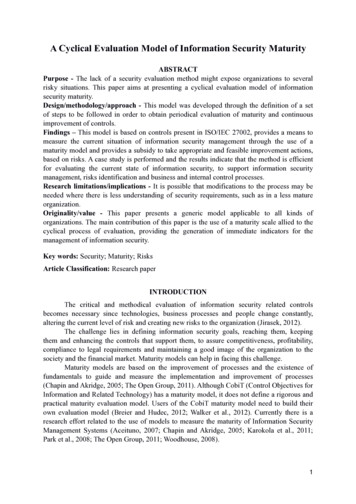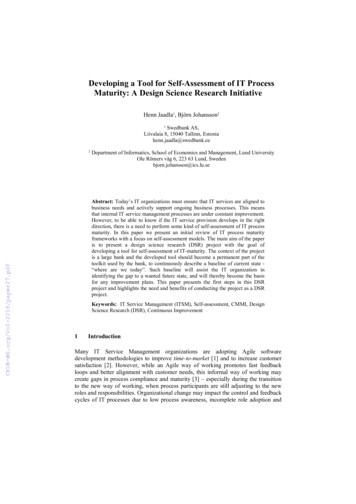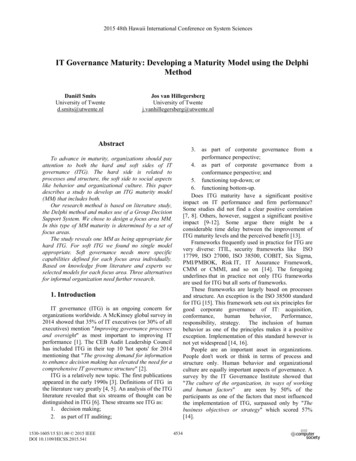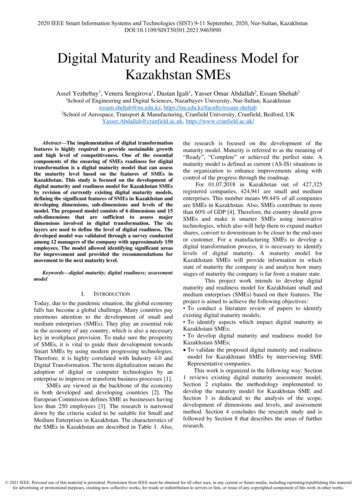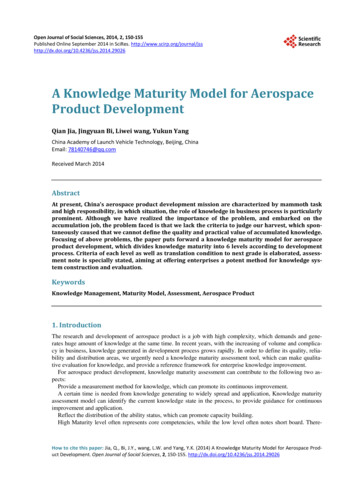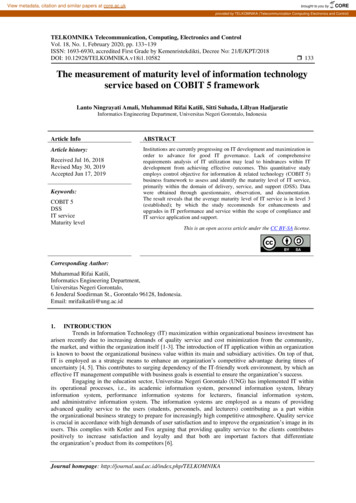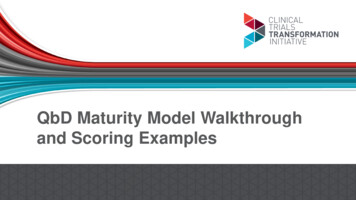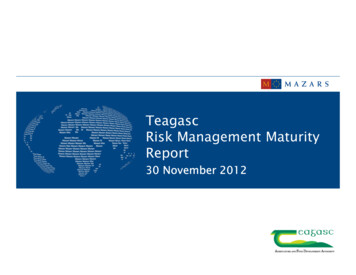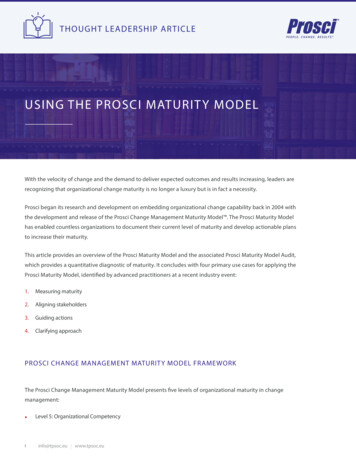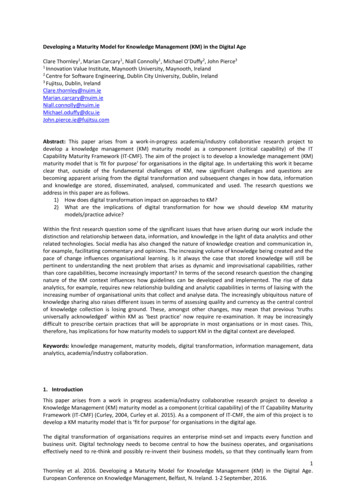
Transcription
Developing a Maturity Model for Knowledge Management (KM) in the Digital AgeClare Thornley1, Marian Carcary1, Niall Connolly1, Michael O’Duffy2, John Pierce31Innovation Value Institute, Maynooth University, Maynooth, Ireland2Centre for Software Engineering, Dublin City University, Dublin, Ireland3Fujitsu, Dublin, ierce.ie@fujitsu.comAbstract: This paper arises from a work-in-progress academia/industry collaborative research project todevelop a knowledge management (KM) maturity model as a component (critical capability) of the ITCapability Maturity Framework (IT-CMF). The aim of the project is to develop a knowledge management (KM)maturity model that is ‘fit for purpose’ for organisations in the digital age. In undertaking this work it becameclear that, outside of the fundamental challenges of KM, new significant challenges and questions arebecoming apparent arising from the digital transformation and subsequent changes in how data, informationand knowledge are stored, disseminated, analysed, communicated and used. The research questions weaddress in this paper are as follows.1) How does digital transformation impact on approaches to KM?2) What are the implications of digital transformation for how we should develop KM maturitymodels/practice advice?Within the first research question some of the significant issues that have arisen during our work include thedistinction and relationship between data, information, and knowledge in the light of data analytics and otherrelated technologies. Social media has also changed the nature of knowledge creation and communication in,for example, facilitating commentary and opinions. The increasing volume of knowledge being created and thepace of change influences organisational learning. Is it always the case that stored knowledge will still bepertinent to understanding the next problem that arises as dynamic and improvisational capabilities, ratherthan core capabilities, become increasingly important? In terms of the second research question the changingnature of the KM context influences how guidelines can be developed and implemented. The rise of dataanalytics, for example, requires new relationship building and analytic capabilities in terms of liaising with theincreasing number of organisational units that collect and analyse data. The increasingly ubiquitous nature ofknowledge sharing also raises different issues in terms of assessing quality and currency as the central controlof knowledge collection is losing ground. These, amongst other changes, may mean that previous ‘truthsuniversally acknowledged’ within KM as ‘best practice’ now require re-examination. It may be increasinglydifficult to prescribe certain practices that will be appropriate in most organisations or in most cases. This,therefore, has implications for how maturity models to support KM in the digital context are developed.Keywords: knowledge management, maturity models, digital transformation, information management, dataanalytics, academia/industry collaboration.1. IntroductionThis paper arises from a work in progress academia/industry collaborative research project to develop aKnowledge Management (KM) maturity model as a component (critical capability) of the IT Capability MaturityFramework (IT-CMF) (Curley, 2004, Curley et al. 2015). As a component of IT-CMF, the aim of this project is todevelop a KM maturity model that is ‘fit for purpose’ for organisations in the digital age.The digital transformation of organisations requires an enterprise mind-set and impacts every function andbusiness unit. Digital technology needs to become central to how the business operates, and organisationseffectively need to re-think and possibly re-invent their business models, so that they continually learn from1Thornley et al. 2016. Developing a Maturity Model for Knowledge Management (KM) in the Digital Age.European Conference on Knowledge Management, Belfast, N. Ireland. 1-2 September, 2016.
interactions with customers, suppliers, and partners in the business ecosystem in order to remain competitive.The greater organisational reach of digital transformation across the entire organisation and the businessecosystem gives rise to new significant challenges and questions associated with the growth of relevant dataand associated changes in terms of how data, information and knowledge are stored, disseminated, analysed,communicated, and used. The research questions we address in his paper are as follows.1) How does digital transformation impact on approaches to KM?2) What are the implications of digital transformation for how we should develop maturity models orpractice advice?This paper is organised as follows. Section 2 provides a contextual background to IT-CMF and the scope of itsKM capability. Section 3 presents the output from a literature review that addresses our first researchquestion, namely ‘How does digital transformation impact an approaches to knowledge management?’.Section 4 discusses the second research question in terms of the implications of digital transformation for howKM maturity models and practice advice should be developed. This is based on a discussion of our experiencesdeveloping our KM maturity model. Finally, section 5 presents our conclusions where we summarise andreflect on the key issues raised.2. IT-CMF and scope of its KM-related capabilityIT-CMF is an action-oriented IT capability toolset of 35 IT-related critical capabilities (one of which is KM)developed by the Innovation Value Institute (IVI) research entity. Each capability is divided into a series ofcategories and associated capability building blocks, and for each capability, a series of management insights,maturity roadmaps, assessment instruments, and improvement guidelines has been developed. Theframework’s five-level maturity curve, ranging from initial to optimizing, enables organisations tosystematically assess and understand their current IT capability maturity, strategically prioritize specificcapabilities, and move toward their desired target maturity state (Curley et al., 2015). This work is supportedby a diverse international consortium of organisations, government agencies, and academic institutions, thataim to address the challenges faced in optimizing the business value derived from the application of IT throughan open innovation, collaborative design science approach (Curley et al., 2015) that incorporates the insightsof workgroups of subject matter experts from both industry and academia.IVI is currently in the process of updating the IT-CMF body of knowledge to develop and increase its relevanceto the continually evolving digital environment. This activity involves an assessment of what has changed as aresult of digital transformation in the relevant critical capability, in this case KM, and the implications of thisfor accurately describing the key components, named within the framework as categories and capabilitybuilding blocks, as well as providing informative guidance in terms of associated maturity levels. We need tobe able to accurately show the characteristics of a high maturity state for the different aspects of the KMcapability in the digital age. Any analysis of what has changed within KM must also incorporate anacknowledgement of what has remained constant and fixed within KM. In terms of developing maturitymodels and practice guidelines we need to be cognisant of the sometimes overly hyped digital revolutionagenda and thus need to provide considered information on what practices are unlikely to need adapting andwhich ones do, in fact, need to change to appropriately respond to different challenges. In order to providesome background to our development work we outline below the goals, objectives and value statement of theexisting IT-CMF KM-related capability (referred to within version 1 of IT-CMF as Knowledge AssetManagement) (Curley et al., 2015).The goal of the capability is centred on getting the right knowledge, to the right people, at the right time, andthereby improving the quality of decision-making. Its objectives include to: Promote access to formalized documented knowledge and tacit, contextual knowledge by facilitatingcollaboration and communication between employees and, where appropriate, between employeesand external experts. Scan the business environment to identify knowledge that is relevant to the organisation. Coordinate with those managing the other multiple sources of organisational data to incorporate alldata into knowledge insights. Organise and index knowledge assets so that they can be easily found and accessed. Maximise the effective use of knowledge through facilitating learning and knowledge application to,for example, innovation.Thornley et al. 2016. Developing a Maturity Model for Knowledge Management (KM) in the Digital Age.European Conference on Knowledge Management, Belfast, N. Ireland. 1-2 September, 2016.2
Measure the use and impact of knowledge assets for relevant organisational activities including, forexample, research and development, operations, and training.The value derived from this capability includes the facilitating of better learning and organisational decisionmaking by leveraging and applying knowledge (Curley et al., 2015).3. How does digital transformation impact on approaches to KM?This literature review outlines the fundamental issues or concepts within KM, including its relationship toinformation and data. It further discusses the ways in which digital transformation has changed KM, and theimplications of these changes for managing a KM capability in a digital business landscape.3.1 Historical context - the fundamentals of KMThe use of IT to facilitate and help manage knowledge is a relatively new development but the problem of howto store knowledge so that people can find it and then use it has existed for millennia. KM must be understoodin the context of the complexity of this problem. The relationship between data, information and knowledge isoften discussed as an introduction to the problem of knowledge management, as explained in, for example,(Alavi and Leidner, 2001). The traditional view is that they exist in a hierarchy of complexity starting with dataand finishing at the apex of knowledge. KM is then the application of appropriate management techniques tomaximize the quality of what happens at the ‘apex of knowledge’ and its subsequent usefulness to theorganisation. The nature of this process and the relationship between data, information and knowledge is,however, disputed. (Tuomi, 1999), as an influential example, argues that data makes sense only after we haveinformation, and that information emerges only after we already have knowledge. As discussed by (Alavi andLeidner, 2001) this reversed hierarchy of knowledge is shown to lead to a different approach to developinginformation systems that support knowledge management and effective learning insofar as sharedunderstanding must come before information or data can be of use. (Alavi and Leidner, 2001), finish theirreview of KM with the conclusion “that information is converted to knowledge once it is processed in the mindof individuals and knowledge becomes information once it is articulated and presented in the form of text,graphics, words, or other symbolic forms” (p.109).Knowledge is a subjective understanding which can be formalized into an external source as information (e.g.in an article), which can then provide a framework for data to be interpreted. This distinction between tacitknowledge (in someone’s head) and explicit knowledge (in an external form) is a divide well established in theliterature and also within related fields such as information sciences, for example, Buckland’s distinctionbetween ‘information as thing’, ‘information as process’, and ‘information as knowledge’ (Buckland, 1991). Hismodel proposes that knowledge or information systems can store explicit knowledge or ‘information as thing’and this should facilitate learning processes ‘information as process’ that eventually lead to tacit knowledge‘information as knowledge’ and appropriate action or decisions. The fundamental challenge of KM is that itmanages or coordinates entities, such as documents, data etc., which may in themselves appear relativelystraightforward but the process by which they are used by humans to develop and then apply knowledge isoften nonlinear and unpredictable.3.2 The impact of digital transformation on KMThe major shift that has happened in KM arising from the new digital landscape is the increase in the amountand types of data, information and knowledge that is available and the associated rise in the number of peoplewho can therefore provide and use these for an organisation (Mackay et al., 2015). This has influenced therelationship between data, information and knowledge and changed the power relationship between differentstakeholders. It has also exacerbated the problem of the need for contextual or indeed expert knowledge to‘make sense’ of data (Mackay et al., 2015) and raised challenges in finding effective ways to judge thetrustworthiness and authority of information coming from so many new and often unfamiliar sources(Watkinson et al., 2015). The rise of the ‘internet of things’ in which objects can provide data (Kaivo-oja, et al.2015) has the potential to recharge KM as a management practice but also raises new ethical andorganisational dilemmas. Knowledge integration from this new range of sources rather than knowledgeproduction becomes the key challenge and existing KM processes and models are unlikely to be ‘fit forpurpose’. This also has an impact on the management of KM relationships with the wider organisationalstructure as the range of organisational units that collect data, and are thus potentially relevant as knowledgesources, is growing. Organisations are also becoming increasingly global and new social web technologies, byThornley et al. 2016. Developing a Maturity Model for Knowledge Management (KM) in the Digital Age.European Conference on Knowledge Management, Belfast, N. Ireland. 1-2 September, 2016.3
providing access to both knowledge context and content, can assist in overcoming the barriers of distance andtime engendered by increasing internationalization and enable distributed organisations to thrive (Siakas, etal., 2010).The environment in which organisations now operate is much more volatile and erratic than when the KMdiscipline was established, and organisations need capabilities to operate and react to these changes (Kaivooja et al., 2015). Thus the major change for KM is not so much in terms of managing knowledge content, astechnology has developed to deal with this, but in terms of how people can effectively respond to, learn fromand apply that content. Learning is becoming even more important and continuous informed adaption is nowcrucial (Lee et al., 2012). This is likely to also involve the ability to forget or not to act on knowledge gainedfrom past experiences as this may no longer be valid in the current environment (Pavlou and El Sawy, 2010).The traditional KM emphasis on the importance of learning from past knowledge is now challenged in somecases. The tension and the relationship between learning from previous knowledge and being able to adaptand change direction as new knowledge comes into an organisation is becoming more pronounced and this isa difficult conflict for organisations to manage. Knowledge and expert understanding is, in one sense, neededmore than ever to interpret and ‘make sense’ of the increase in data and information coming into anorganisation but experts must also be flexible enough to make radical rather than incremental shifts inpractice, based on that input, if necessary.This ability to effectively use and apply knowledge to actually make a positive difference to an organisation iskey to gaining value from KM and is most influentially discussed, introducing the term ‘absorptive capacity’,by (Cohen and Levinthal, 1990). The evidence on the actual improvements brought about by effective KM isdifficult to reliably quantify but this ability to transfer knowledge to appropriate action has emerged as a keycritical success factor (Serenko and Dumay, 2015). There is some evidence that the careful use of social IT canassist in enabling effective knowledge transfer to action (Siakas et al. , 2010).One interesting question is the issue of locating useful key performance indicators (KPIs) to help organisation’smeasure their KM performance. The distinction made by Gold (Gold, 2001) between KPIs specific to KM andmore general organisational KPIs, which are nevertheless dependent on KM, does still seem to hold as a usefulapproach within the digital environment. KM is not an ‘end in itself’ so high performance in KM based purelyon KM metrics is of limited value if it cannot also be demonstrated that it is having an impact on relatedorganisational metrics (e.g. speed of response to new information on changes in the market). Although it is notpossible to measure tacit knowledge, it can be possible to develop mechanisms to measure its impact asdiscussed by (Chen and Fong, 2012) in their paper on KM and developing dynamic capabilities.4. What are the implications of digital transformation for how we should develop KM maturity models andpractice advice?In this section we discuss our experience of developing a KM maturity model that is ‘fit for purpose’ in thedigital age and highlight the most intractable and difficult concepts with a particular focus on ones which wefeel have been most influenced by digital transformation. The purpose of this is to inform the debate on howresearch can best guide KM practice through maturity models by investigating a particular instance of thisprocess. Firstly, we will provide a simplified overview of the key concepts we included in our KM criticalcapability in order to facilitate feedback from any readers. Secondly, we select some of these concepts anddiscuss some of the challenges encountered in developing guidelines for those concepts. Finally, we discusssome further general challenges with the rationale for maturity models in the context of such a fast changingenvironment.4.1 Key concepts (capability building blocks) of the KM capabilityThe table below outlines the conceptual model we developed for the KM capability which consists of somegeneric categories and more specific capability building blocks. These concepts were derived throughdiscussion with KM industry and academic subject matter experts.Thornley et al. 2016. Developing a Maturity Model for Knowledge Management (KM) in the Digital Age.European Conference on Knowledge Management, Belfast, N. Ireland. 1-2 September, 2016.4
CategoryCapability modelCapability Building BlockCultureStructures/RelationshipsOrganisational CognitionPeopleProcessesHarvesting the capabilityTools and TechnologiesStrategy Development, Review, and Target-SettingKnowledge Discovery and CaptureKnowledge Asset Organisation/Classification and AccessKnowledge AnalysisKnowledge SharingGovernance4.2 Challenges encountered in developing KM concept guidanceThis section highlights a number of key concepts about which some of the most complex discussions were had,e.g. in relation to their definition/scope and a description of ‘what good looks like’.4.1.1 Knowledge AnalysisThe scope of the knowledge analysis capability building block is defined as follows. ‘To establish andimplement processes, skillsets, tools and linkages (e.g. to tacit knowledge) to seek and derive insights andintelligence from the organisation’s existing/accumulated knowledge resources in order to facilitate informeddecision-making. This may arise both in response to general guidelines as prescribed by the KM strategy, andspecific enquiries arising from within the organisation’.Knowledge analysis is an area which has perhaps been most influenced by digital transformation as newtechnologies which facilitate both the generation of and the potential ‘sense making’ from large amounts ofdata, information and knowledge are becoming more common place. Organisations need to improve atanalysing large amounts of data in ways that will provide them with new knowledge. The traditional dividebetween data processing, information management and knowledge management is shifting in organisations.When developing maturity guidelines for this KM concept we needed to consider the effective and appropriateuse of data analytics technology, whilst also considering that the ability to ‘ask the right’ questions of the datawas essentially a knowledge management skill rather than a purely technical ability. The growth of dataanalytics also increases the need for those working in KM to effectively coordinate and collaborate with newstakeholders as the potential sources for useful input into knowledge grow. It thus also has an influence onother KM concepts such as ‘People’ and ‘Structures and Relationships’. Technological developments have alsoinfluenced the relationship between ‘knowledge asset/classification and access’ and ‘knowledge analysis’ as itis no longer always the case that classification comes before analysis. There are now multiple ways to view andorganise data and information to provide potential knowledge and these are often done in real time on an ‘asneeded’ basis.4.1.2 Knowledge Discovery and CaptureThe scope of the knowledge discovery and capture capability building block is defined as follows. ‘To establishthe mechanisms (processes, roles, skillsets, sources, and linkages e.g. agent networks, connection to experts)to locate, evaluate, assemble and record knowledge that exists either within or external to the organisation, asdirected by, for example, KM strategy or specific investigation requests’.The increasing amount of potential sources of knowledge presents new challenges for knowledge discoveryand capture. A particular problem is developing the capability to effectively evaluate sources in terms ofThornley et al. 2016. Developing a Maturity Model for Knowledge Management (KM) in the Digital Age.European Conference on Knowledge Management, Belfast, N. Ireland. 1-2 September, 2016.5
authority and trustworthiness. The growth of social media provides new possible sources of useful knowledgebut it also bypasses most tried and tested methods that people use to establish legitimacy in terms of its lackof peer review (in many cases) and other traditional barriers to the publishing of inaccurate information4.1.3 GovernanceThe scope of the governance capability building block is defined as follows. ‘Monitor and oversee the extentto which the knowledge management strategy is aligned with the business strategy. Track the extent to whichthe knowledge management strategy is being properly implemented by the knowledge managementprogramme. Define and use processes to assess and ensure, for example, the integrity, completeness, andcurrency of knowledge assets’.The increasingly ubiquitous capture, storage, and analysis of data, information and knowledge presents newpotential governance challenges in terms of who really is responsible for knowledge. As captured in ourdefinition above we have focussed on responsibility for ensuring that strategy and processes are congruentwith the needs of the organisation. It is debatable whether this should also include more legal and complianceresponsibilities in terms of how knowledge is collected, stored and shared. As regulations around data,information and knowledge grow, providing guidance on ‘best practice’ also merges into providing legal adviceon compliance with all the associated potential pitfalls.4.3 Implications of digital transformation on the value and use of KM maturity modelsIn this section we briefly highlight some more general points on the impact of digital transformation on theoverall value and purpose of KM maturity models in terms of our understanding of best practice andorganisational learning.4.3.1 Does best practice still exist?The pace of technological change and the increasing volume of research which could potentially informpractice makes it more challenging to define and prescribe certain practices as being more likely to lead tosuccess than others. It may be that maturity models need to slightly shift their approach in describing differentmaturity levels of practice in ways which are less tied to particular technologies or environmental assumptions.This then may require further support and guidelines within the model or in supporting its implementation soorganisations can adapt it to their particular situation.4.3.2 Organisational learningAn underlying shared assumption/belief of our work is that whilst information and data can be storedexternally, knowledge is essentially something that can only exist inside someone’s head. As such, insofar asknowledge can be managed, it is fundamentally a problem of managing people in terms of what thoseindividuals know and how they share and use what they know. The aforementioned pace of change haschallenged traditional learning approaches and now most employees are required to update their learningthroughout their career. The problem of how this can be best managed in the increasingly fast pace of modernworkplaces, which is both an impetus and a potential barrier to learning, is perhaps something that KM needsto become more concerned about. The end of a ‘job for life’ for most people and an increasingly pragmaticworkforce who are prepared and indeed often forced to move jobs with reasonable frequency is a significantchallenge for retaining, developing and using knowledge for organisations.5. ConclusionsIn this paper we have outlined some of the major shifts occurring in KM as result of digital transformation andsome of the subsequent challenges in developing KM maturity models that can help guide and adviseorganisations on improving their KM capability. Managing knowledge is a fundamentally challenging activitybecause of its intangible nature and its dependence on the actions and behaviours of people. In many waysnew digital developments have made it easier to collect, store and analyse data and information in ways thatcan provide knowledge, but it has also undeniably made it harder in others. In a similar way, the fast pace ofchange makes it more important than ever for people to know ‘what is new’ and judge its relevance to theirorganisation but it also presents them with challenges in doing this effectively. KM maturity models are oneway to help organisations to do this but we need to ensure that as we develop practice guidelines we find aThornley et al. 2016. Developing a Maturity Model for Knowledge Management (KM) in the Digital Age.European Conference on Knowledge Management, Belfast, N. Ireland. 1-2 September, 2016.6
way to describe best practice which is actually useful for those operating in such a complex and challengingenvironment. This may require some re-thinking of how best to go about developing KM maturity models andwe actively welcome any feedback on our work thus far.ReferencesAlavi, M. and Leidner, D.E., 2001. Review: Knowledge Management and Knowledge Management Systems:Conceptual Foundations and Research Issues. MIS Quarterly, 25(1), pp.107-136.Buckland, M.K., 1991. Information as thing. Journal of the American Society for Information Science, 42(5),pp.351–360.Chen, L. and Fong, P.S.W., 2012. Revealing performance heterogeneity through knowledge managementmaturity evaluation: A capability-based approach. Expert Systems with Applications, 39(18), pp.13523–13539.Cohen, W.M. and Levinthal, D.A., 1990. Absorptive Capacity: A New Perspective on Learning and Innovation.Administrative Science Quarterly, 35(1), pp.128-152Curley, M., Kenneally, J., Carcary, M., Doherty, E., Conway, G., Crowley, C., O’Brien, C., Thornley, C., Murnane,S. and Veiling, L., 2015. IT Capability Maturity Framework(TM) (IT-CMF TM) The Body of Knowledge Guide.Netherlands: Van Haren Publishing, Zaltbommel, www.vanharen.net.Gold, A.H., Malhotra, A.and Segars, A.H. 2001Knowledge management: An organizational capabilitiesperspective. Journal of Management Information Systems; 18 (1), pp.185-214.Kaivo-oja, J., Virtanen, P., Jalonen, H. and Stenvall, J., 2015. The Effects of the Internet of Things and Big Datato Organizations and Their Knowledge Management Practices. [online] International Conference on KnowledgeManagement in Organizations. Springer International Publishing, pp.495–513. Available at: -21009-4 38 [Accessed 2 Dec. 2015].Lee, S., Gon Kim, B. and Kim, H., 2012. An integrated view of knowledge management for performance. Journalof Knowledge Management, 16(2), pp.183–203.Mackay, E.B., Wilkinson, M.E., Macleod, C.J.A., Beven, K., Percy, B.J., Macklin, M.G., Quinn, P.F., Stutter, M. andHaygarth, P.M., 2015. Digital catchment observatories: A platform for engagement and knowledge exchangebetween catchment scientists, policy makers, and local communities: DIGITAL CATCHMENT OBSERVATORY:AIDING STAKEHOLDER ENGAGEMENT. Water Resources Research, 51(6), pp.4815–4822.Pavlou, P.A. and El Sawy, O.A., 2010. The ‘Third Hand’: IT-Enabled Competitive Advantage in TurbulenceThrough Improvisational Capabilities. Information Systems Research, 21(3), pp.443–471.Serenko, A. and Dumay, J., 2015. Citation classics published in knowledge management journals. Part I: Articlesand their characteristics. Journal of Knowledge Management, 19(2), pp.401–431.Siakas, K. V, Georgiadou, E. and Balstrup, B., 2010. Cultural impacts on knowledge sharing: empirical data fromEU project collaboration. VINE, 40(3/4), pp.376–389.Tuomi, I., 1999. Data Is More Than Knowledge: Implications of the Reversed Knowledge Hierarchy forKnowledge Management and Organizational Memory. Journal of Management Information Systems, 16(3)
Knowledge Management (KM) maturity model as a component (critical capability) of the IT Capability Maturity Framework (IT-CMF) (Curley, 2004, Curley et al. 2015). As a component of IT-CMF, the aim of this project is to develop a KM maturity model that is fit for purpose [ for organisations in the digital age.


